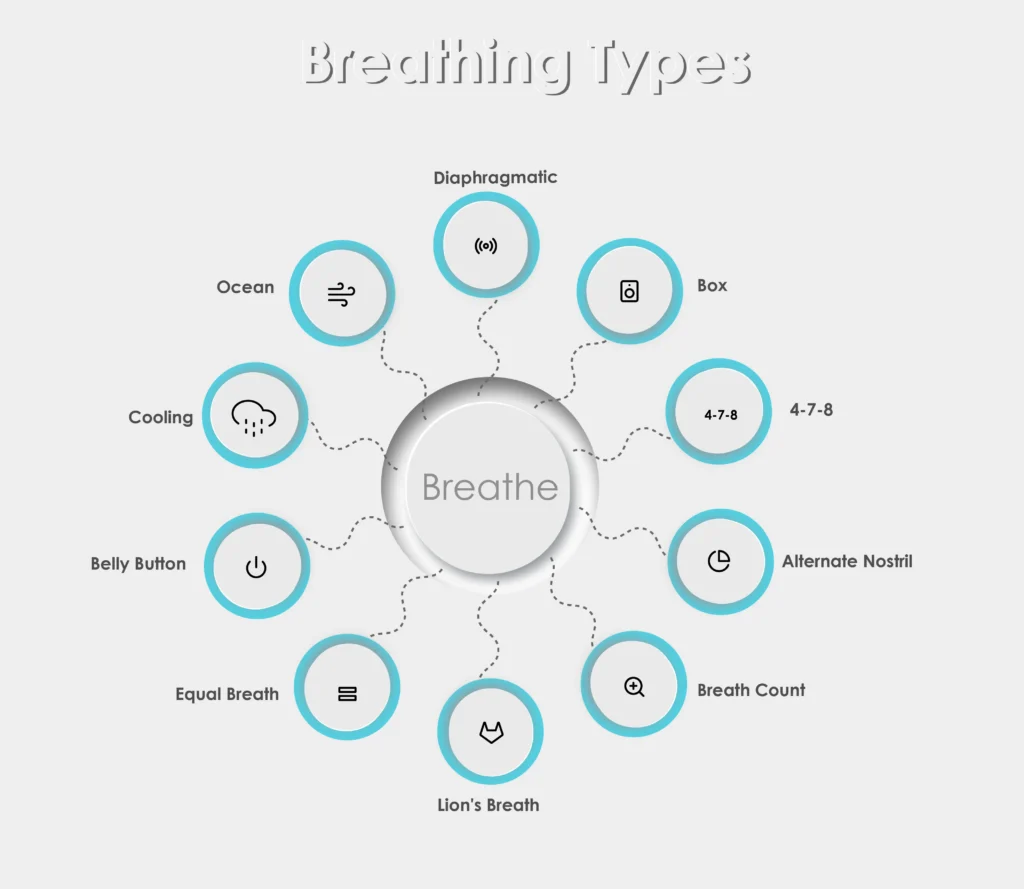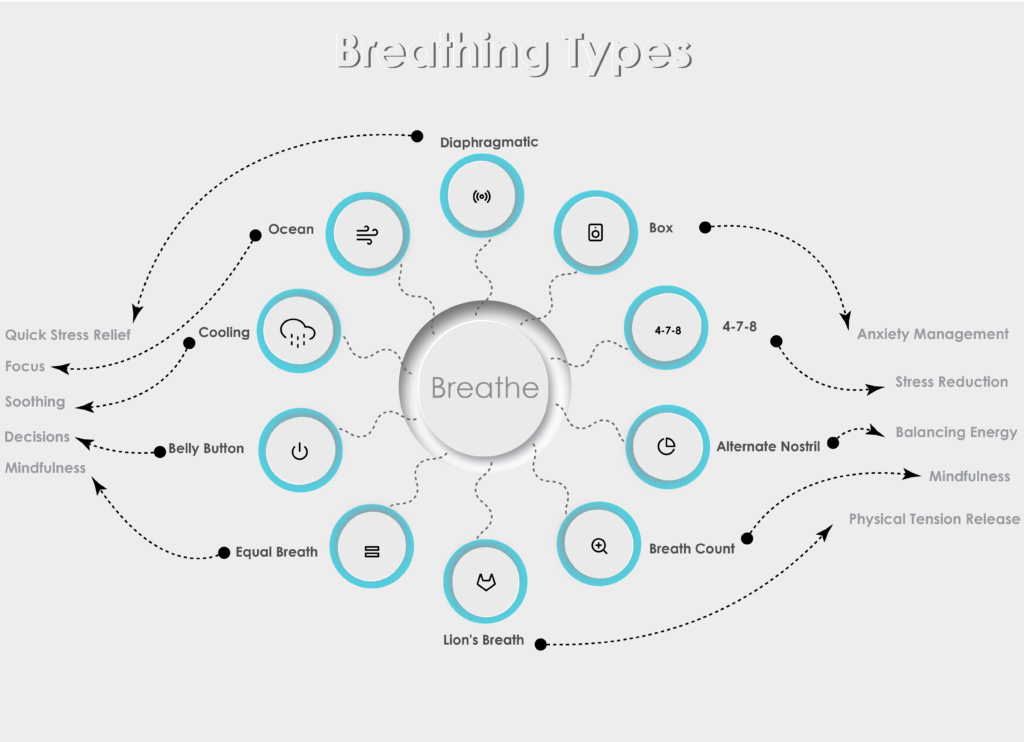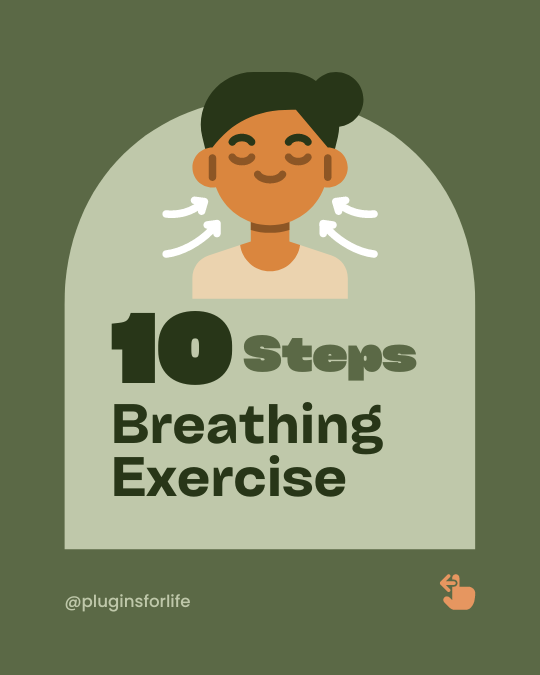Here are the 10 different breathing techniques that can help you manage stress, improve focus, and promote relaxation:
While I have tried all of them atleast twice , I have realised that few of the techniques were easy to execute , while others needed a bit of practice, while there were some , which my body and mind …simply resisted..!! Since I wanted the breathing exercise to be fluid..I chose those which felt more natural to me.
You might experience the same – in that case I suggest that you choose those which you naturally feel attached to .

Diaphragmatic Breathing (Deep Breathing)
- Sit or lie down comfortably.
- Place one hand on your chest and the other on your abdomen.
- Inhale deeply through your nose, allowing your abdomen to rise as you fill your lungs.
- Exhale slowly through your mouth, letting your abdomen fall.
- Focus on the rhythm of your breath, taking slow and controlled breaths.
- Repeat for several minutes to calm your nervous system and reduce stress.
- Increases oxygen supply to the body, promoting better overall health.
- Enhances lung capacity and efficiency.
Box Breathing (Square Breathing)
- Sit in a comfortable position and keep your back straight.
- Inhale through your nose for a count of four.
- Hold your breath for a count of four.
- Exhale slowly through your mouth for a count of four.
- Pause and hold your breath for another count of four.
- Repeat this pattern for several cycles (usually 4-5 times).
- Box breathing can help improve focus and reduce anxiety.
- Promotes relaxation by balancing the autonomic nervous system.
- Reduces anxiety and helps improve focus and mental clarity.
- Can be used to manage stress during high-pressure situations.
4-7-8 Breathing (Relaxing Breath)
- Sit or lie down comfortably and close your eyes.
- Inhale quietly through your nose for a count of four.
- Hold your breath for a count of seven.
- Exhale completely through your mouth for a count of eight, making a whooshing sound.
- This technique can help you relax, reduce stress, and improve sleep quality.
- Can reduce the body’s “fight-or-flight” response.
Alternate Nostril Breathing (Nadi Shodhana)
- Sit in a comfortable position with your back straight.
- Use your right thumb to close your right nostril and inhale through your left nostril.
- Close your left nostril with your right ring finger, release your thumb from your right nostril, and exhale through the right nostril.
- Inhale through your right nostril.
- Close your right nostril with your thumb, release your ring finger from your left nostril, and exhale through the left nostril.
- Continue this cycle for several minutes to balance energy, reduce stress, and improve focus
- Enhances the functioning of the respiratory and cardiovascular systems.
Breath Counting Meditation
- Sit comfortably with your eyes closed.
- Inhale and exhale naturally, without trying to control your breath.
- Count each inhale and exhale, starting from 1 and going up to 10.
- If your mind wanders or you lose count, gently return your focus to the breath and start counting again from 1.
- Develops mindfulness and the ability to stay present.
- Helps calm racing thoughts and promotes relaxation.
Lion’s Breath (Simhasana Pranayama)
- Sit in a comfortable cross-legged position.
- Inhale deeply through your nose.
- As you exhale forcefully through your mouth, open your mouth wide, stick out your tongue, and roar like a lion.
- This technique can help release tension in the face and throat and reduce stress.
- Encourages a sense of playfulness and lightness.
Ujjayi Breathing (Ocean Breath)
- Sit comfortably with your back straight or lie down.
- Inhale deeply through your nose, slightly constricting the back of your throat to create a soft “ocean” sound.
- Exhale through your nose using the same throat constriction.
- This yoga breath is calming and helps enhance focus and concentration.
- Deepens the breath and increases oxygen intake
Sama Vritti (Equal Breathing)
- Sit or lie down comfortably.
- Inhale and exhale for the same count, such as inhaling for a count of four and exhaling for a count of four.
- Maintain an even rhythm without pausing between inhalation and exhalation.
- This technique promotes balance, reduces anxiety, and enhances mental clarity
- Balances the mind and body by promoting equilibrium.
- Reduces anxiety and brings about a sense of calm and clarity.
- Helps improve concentration and decision-making.
Belly Button Healing Breathing
- Sit comfortably with your eyes closed and your hands resting on your lower abdomen.
- Inhale deeply through your nose, allowing your abdomen to expand and your belly button to push out.
- Exhale through your nose, gently contracting your abdomen and bringing your navel toward your spine.
- Focus on the movement of your belly button with each breath, promoting relaxation and abdominal strength.
- Strengthens the abdominal muscles and diaphragm.
- Promotes relaxation and reduces tension in the abdominal area.
- Aids digestion and supports overall abdominal health.
Sitali Pranayama (Cooling Breath)
- Roll your tongue into a tube shape or if you can’t, purse your lips slightly.
- Inhale slowly and deeply through the tongue or pursed lips, as if you are sipping through a straw.
- Exhale slowly and completely through your nose.
- This breath is believed to have a cooling effect on the body and can help reduce body heat and stress.
- Cools the body and reduces heat-related discomfort.
- Calms the mind and soothes emotional turmoil.
- Can help alleviate symptoms of anger, anxiety, and irritability
Best beneficial techniques for different scenarios
- Stress Reduction and Relaxation:
- 4-7-8 Breathing: This technique is excellent for quickly reducing stress and inducing a sense of calm and relaxation. It’s especially useful before bedtime.
- Anxiety Management:
- Box Breathing: Box breathing can help regulate your nervous system and reduce anxiety in high-pressure situations.
- Concentration and Mental Clarity:
- Ujjayi Breathing: This technique is often used in yoga and meditation to enhance focus and concentration by creating a soothing, rhythmic breath.
- Balancing Energy:
- Alternate Nostril Breathing (Nadi Shodhana): When you need to balance your energy or calm racing thoughts, this technique can be effective.
- Quick Stress Relief:
- Diaphragmatic Breathing: When you’re feeling stressed but don’t have much time, diaphragmatic breathing is a simple and effective choice.
- Physical Tension Release:
- Lion’s Breath (Simhasana Pranayama): This technique is great for releasing physical tension in the face and throat while adding an element of playfulness.
- Overall Mindfulness and Well-Being:
- Breath Counting Meditation: For daily mindfulness practice and improving your overall sense of well-being, this technique can be valuable.
- Cooling and Soothing:
- Sitali Pranayama (Cooling Breath): When you’re feeling overheated or emotionally agitated, this breath can help cool you down.
- Ultimately, the “best” technique depends on your specific goals, your comfort with the practice, and the situation you’re in. It can be helpful to experiment with different techniques to see which one works best for you in different circumstances. Over time, you may find that certain techniques become your go-to practices for specific needs.

